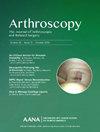脂肪浸润、撕裂大小和回缩大小是关节镜下肩袖修复术后发生再撕裂的重要风险因素:系统回顾
IF 4.4
1区 医学
Q1 ORTHOPEDICS
Arthroscopy-The Journal of Arthroscopic and Related Surgery
Pub Date : 2025-05-01
DOI:10.1016/j.arthro.2024.06.040
引用次数: 0
摘要
目的:评估肩袖修复术(RCR)再撕裂风险因素报告的一致性和质量,并确定最常与再撕裂相关的风险因素:方法:按照 PRISMA 指南进行了系统性回顾。在最初的 3,158 个标题中,共有 31 项研究符合以下纳入标准:(1) 有关 RCR 失败的临床研究;(2) 涉及 RCR 的关节镜手术;(3) 报告临床结果;(4) 5 年内进行的手术;(5) 调查术前再撕裂风险因素的研究。全文查阅后,对18个风险因素进行了分析:最显著的风险因素是肩峰距离(AHD,80%)、临界肩角(CSA,67%)、撕裂大小(63%)、前后(AP)尺寸(60%)、脂肪浸润(FI,58%)和回缩大小(56%)。不同研究采用不同方法对脂肪浸润进行分析,63%的研究结果显著,50%的研究采用序数分析。泪痕大小的定量或定性分析方法不一致,58%的研究结果显著,63%的研究采用定量分析。一直被认为不显著的风险因素包括年龄、性别、糖尿病(DM)、症状持续时间、手部优势、修复技术、吸烟和体重指数(BMI):结论:在大多数纳入的肩袖再撕裂评估研究中,撕裂大小、脂肪浸润和回缩大小都是重要的风险因素。较少报道的风险因素包括修复技术、年龄、性别、糖尿病、症状持续时间、手部优势、修复技术、吸烟和体重指数。需要进一步研究的风险因素包括CSA、AHD和AP撕裂维度。III级,对III-V级研究的系统回顾。本文章由计算机程序翻译,如有差异,请以英文原文为准。
Fatty Infiltration, Tear Size, and Retraction Size Are Significant Risk Factors for Retear After Arthroscopic Rotator Cuff Repair: A Systematic Review
Purpose
To assess the consistency and quality of risk factor reporting for rotator cuff repair (RCR) retear and identify risk factors most frequently associated with retear.
Methods
A systematic review was performed according to Preferred Reporting Items for Systematic Reviews and Meta-analyses (PRISMA) guidelines. Of the initial 3,158 studies, a total of 31 met the following inclusion criteria: (1) clinical studies regarding RCR failure, (2) arthroscopic procedures involving RCR, (3) reporting of clinical outcomes, (4) publication within the past 5 years, and (5) studies investigating preoperative risk factors for retear. After full-text review, 18 risk factors were analyzed.
Results
The most consistently significant risk factors were acromiohumeral distance (80%), critical shoulder angle (67%), tear size (63%), anterior-posterior dimension (60%), fatty infiltration (FI) (58%), and retraction size (56%). FI was analyzed using different methods among studies, with 63% finding significant results and 50% of all studies performing ordinal analysis. Tear size was inconsistently analyzed quantitatively or qualitatively, with 58% of studies finding significant results and 63% of all studies performing quantitative analysis. Risk factors consistently found to be nonsignificant included age, sex, diabetes mellitus, symptom duration, hand dominance, repair technique, smoking, and body mass index.
Conclusions
Tear size, FI, and retraction size were found to be significant risk factors in most of the included studies evaluating rotator cuff retear. Risk factors less likely reported as predictive included repair technique, age, sex, diabetes mellitus, symptom duration, hand dominance, repair technique, smoking, and body mass index. Risk factors that require further investigation include critical shoulder angle, acromiohumeral distance, and anterior-posterior tear dimension.
Level of Evidence
Level III, systematic review of Level III-IV studies.
求助全文
通过发布文献求助,成功后即可免费获取论文全文。
去求助
来源期刊
CiteScore
9.30
自引率
17.00%
发文量
555
审稿时长
58 days
期刊介绍:
Nowhere is minimally invasive surgery explained better than in Arthroscopy, the leading peer-reviewed journal in the field. Every issue enables you to put into perspective the usefulness of the various emerging arthroscopic techniques. The advantages and disadvantages of these methods -- along with their applications in various situations -- are discussed in relation to their efficiency, efficacy and cost benefit. As a special incentive, paid subscribers also receive access to the journal expanded website.

 求助内容:
求助内容: 应助结果提醒方式:
应助结果提醒方式:


